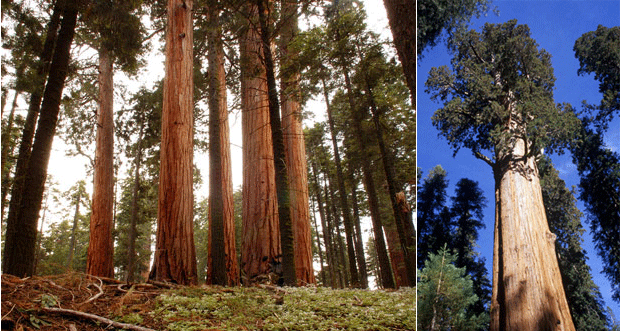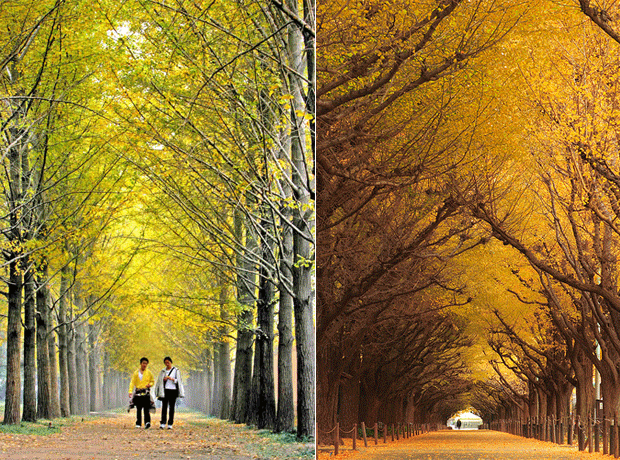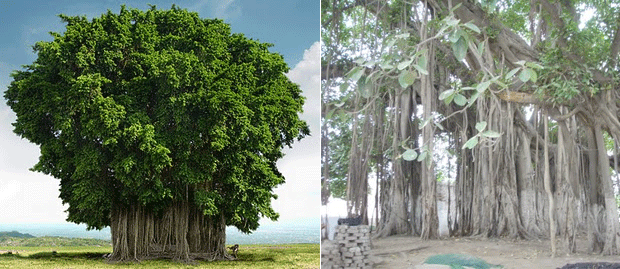|
Trees frame life, providing shade, oxygen, food,
homes, heat and of course, building materials. There are an estimated
100,000 different species of trees comprising a quarter of all living
plant species around the world. Spread among the billions of trees
around the globe are a few special ones, especially worthy of attention.
Here are seven of the world's most amazing trees.
|
|
Giant Sequoias
Giant Sequoias [wiki] (Sequoiadendron giganteum), which only grow in
Sierra Nevada, California, are the world’s biggest trees (in terms of
volume). The biggest is General Sherman [wiki] in the Sequoia National
Park – one behemoth of a tree at 275 feet (83.8 m), over 52,500 cubic
feet of volume (1,486 m³), and over 6000 tons in weight. General Sherman
is approximately 2,200 years old – and each year, the tree adds enough
wood to make a regular 60-foot tall tree. It’s no wonder that naturalist
John Muir said "The Big Tree is Nature’s forest masterpiece, and so far
as I know, the greatest of living things." For over a century there was
a fierce competition for the title of the largest tree: besides General
Sherman, there is General Grant [wiki] at King’s Canyon National Park,
which actually has a larger circumference (107.5 feet / 32.77 m vs.
Sherman’s 102.6 feet / 31.27 m). In 1921, a team of surveyors carefully
measured the two giants – with their data, and according to the complex
American Forestry Association system of judging a tree, General Grant
should have been award the title of largest tree – however, to simplify
the matter, it was later determined that in this case, volume, not point
system, should be the determining factor.
|
|
 |
|
Coast Redwood: Hyperion and Drive-Thru Trees
There is another sequoia species (not to be confused with Giant Sequoia)
that is quite remarkable: the Coast Redwood [wiki] (Sequoia sempervirens),
the tallest trees in the world. The reigning champion is a tree called
Hyperion in the Redwood National Park, identified by researcher Chris
Atkins and amateur naturalist Michael Taylor in 2006. Measuring over 379
feet (155.6 115 m) tall, Hyperion beat out the previous record holder
Stratosphere Giant [wiki] in the Humboldt Redwoods State Park (at 370
feet / 112.8 m). The scientists aren’t talking about the exact location
of Hyperion: the terrain is difficult, and they don’t want a rush of
visitors to come and trample the tree’s root system. [Image: The
Stratosphere Giant - still an impressive specimen, previously the
world's tallest tree until dethroned by Hyperion in 2006.] That’s not
all that’s amazing about the Coast Redwood: there are four giant
California redwoods big enough that you can drive your car through them!
The most famous of the drive-through trees is the Chandelier Tree [wiki]
in Leggett, California. It’s a 315 foot tall redwood tree, with a 6 foot
wide by 9 foot tall hole cut through its base in the 1930s.
|
|

|
|
Baobab
The amazing baobab [wiki] (Adansonia) or monkey bread tree can grow up
to nearly 100 feet (30 m) tall and 35 feet (11 m) wide. Their defining
characteristic: their swollen trunk are actually water storage – the
baobab tree can store as much as 31,700 gallon (120,000 l) of water to
endure harsh drought conditions. Baobab trees are native to Madagascar
(it’s the country’s national tree!), mainland Africa, and Australia. A
cluster of "the grandest of all" baobab trees (Adansonia grandidieri)
can be found in the Baobab Avenue, near Morondava, in Madagascar:
|
|

|
|
Ginkgo Biloba Tree
"The ginkgo is the oldest tree in the world," states Botanical-Online,
noting that Ginkgo biloba trees are the lone survivor of a "family that
existed more than 200 million years ago" and kept company with the
dinosaurs in many parts of the world. However, Ginkgo biloba trees
eventually vanished in most regions. In historical times, the Ginkgo
biloba tree's origin is the Far East. The Ginkgo Pages Web site relates
that Ginkgo biloba trees had survived in China, where they were mainly
found in monasteries "in the mountains and in palace and temple gardens,
where Buddhist monks cultivated the tree from about 1100 AD for its many
good qualities." Plant collectors from the West eventually were sold on
Ginkgo biloba trees and brought specimens home. The tree's "good
qualities" included medicinal and culinary uses, exploited for centuries
in both China and Japan. Roasted nuts from Ginkgo biloba trees have long
been considered a delicacy in their native China. The trees medicinal
qualities are now recognized in the West, too. Treatment for short-term
memory loss is just one of many medicinal uses for the extract derived
from the leaves of Ginkgo biloba trees.
|
|

|
|
Banyan Tree: Sri Maha Bodhi Tree
The Banyan tree is named after "banians" or Hindu traders who carry out
their business under the tree. Even if you have never heard of a Banyan
tree (it was the tree used by Robinson Crusoe for his treehouse), you’d
still recognize it. The shape of the giant tree is unmistakable: it has
a majestic canopy with aerial roots running from the branches to the
ground.If you were thinking that the Banyan tree looks like the trees
whose roots snake through the ruins of the Ta Prohm temple like
tentacles of the jungle (Lara Croft, anyone?) at Ankor, Cambodia , you’d
be right! One of the most famous species of Banyan, called the Sacred
Fig [wiki] or Bo tree, is the Sri Maha Bodhi [wiki] tree in
Anuradhapura, Sri Lanka. It is said that the tree was grown from a
cutting from the original tree under which Buddha became enlightened in
the 6th century BC. Planted in 288 BC, it is the oldest living
human-planted tree in the world, with a definitive planting date!
|
|

|